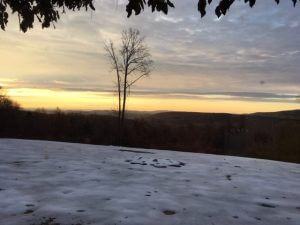2018 Policy Round-Up: From Water-Infrastructure Success to the Dirty Water Rule
Can you remember what you were doing at this time last year—aside from refining your New Year’s resolutions? Some years feel like a blur, with so much happening in policy across the country that you can barely keep up. That’s how 2018 felt to me and, perhaps, to many of you on the frontlines of clean and safe water. So, in this year-end policy wrap-up, we take a look back at what’s happened as we jump into 2019.

Sunset on 2018
First, the good news: Although 2018 ended with Trump’s Dirty Water Rule proposal, there were a number of wins. Many of you played a part in reaching these milestones:
- Water Resources Development Act (WRDA) – Congress passed this water infrastructure bill that included authorization of additional water infrastructure funds via the Drinking Water State Revolving Fund and the Water Infrastructure Finance and Innovation Act (WIFIA) program. The bill officially authorized (at long last) EPA’s Water Sense program – a labeling and certification program for high efficiency appliances, plus programming for workforce development and reducing lead in drinking water, as well as requiring the Corps of Engineers to consider natural approaches like protecting wetlands and floodplains when considering flood control projects. Note that these programs (and Farm Bill programs below) have to go through the appropriations process before they are funded.
- Farm Bill – The Farm Bill also made it to the finish line with bipartisan support. Notably it did not include any major damaging anti-environmental provisions. Among the conservation programs, the bill increases funding authorization for the Regional Conservation Pilot Program (RCPP), which has been used successfully to protect drinking water and prioritize drinking water protection across a number of programs, and requires better tracking and analysis of the effectiveness of Farm Bill–funded conservation approaches.
- East Rosebud Wild and Scenic Rivers Act – 2018 marked the 50th Anniversary of the Wild and Scenic Rivers Act, and Montana’s East Rosebud Creek was added to this national system of rivers. Many years of conversation, work, and trust-building led to this victory supported by local communities. Additionally, a new coalition of groups working together on Wild and Scenic Rivers got started at River Rally 2018. With that coalition we hope to see more wild and scenic river designations in years to come.
- Federal budget – although the process is undeniably dysfunctional (note federal government shutdown…), advocacy groups did a great job at telling the stories of what was at risk and protecting or even growing some investments in clean water and healthy communities in the Fiscal Year 2018 federal budget.
In other good news, reforms to ensure and restore access to the right to vote were won at the state level in many places and voter turnout in the midterm election was at a record high. Anecdotally, it seems like more and more water groups are taking part in non-partisan get-out-the-vote efforts (which are okay for nonprofits to do).
In not-so-good news, the Trump Administration continued to dismantle environmental protections and disavow science. A prime example is the Dirty Water Rule, proposed to limit the scope of the Clean Water Act, allowing additional pollution to threaten our streams and rivers that provide drinking water for one in three Americans. In addition to these obvious threats, there are also threats to the keystone laws that underpin environmental protections like the National Environmental Policy Act.
At River Network, we’re continuing to provide policy updates, tools for analysis of federal changes on the local and state levels (like our federal budget toolkit) and engagement opportunities on a variety of policy issues. We’re also proud to be part of larger coalitions like Clean Water for All and PolicyLink’s Water Equity and Climate Resilience Caucus, where we can collaborate with others to fight back against the seemingly endless attacks on our water, land, and air and look to create a more inclusive and healthy water future for all people.
Victories like passage of WRDA, the Farm Bill and Wild and Scenic designation of East Rosebud Creek – not to mention wins at the state and local levels nationwide – helped sustain us in 2018. Looking forward, there are bright possibilities on the horizon for 2019, which will include many new lawmakers, House oversight on a range of environmental questions, and the serious start of the race to 2020, all of which will influence policies and outcomes. One of my 2019 resolutions is to show gratitude: And so to every one of you across the network digging in deep and advocating for positive change, thank you.




